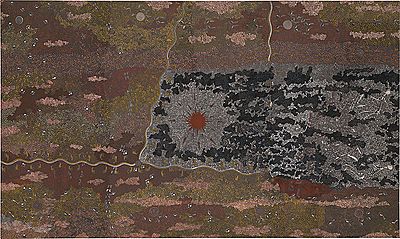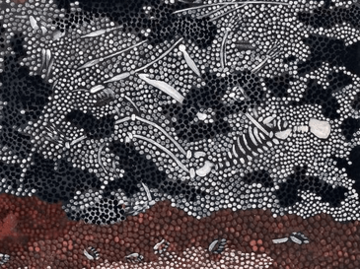Warlugulong facts for kids
Quick facts for kids Warlugulong |
|
|---|---|
 |
|
| Artist | Clifford Possum Tjapaltjarri |
| Year | 1977 |
| Medium | Acrylic paint on canvas |
| Dimensions | 202.0 cm × 337.5 cm (79.5 in × 132.9 in) |
| Location | National Gallery of Australia, Canberra |
Warlugulong is a famous painting from 1977 by Clifford Possum Tjapaltjarri. He was an Indigenous Australian artist. This artwork uses acrylic paint on canvas. For many years, a bank called the Commonwealth Bank owned it.
In 2007, the painting was sold for a record price. The National Gallery of Australia bought it for A$2.4 million. This made it the most expensive contemporary Indigenous Australian art piece sold at auction at that time. The painting tells the story of an ancient being named Lungkata. It also shows eight other "dreamings." These are stories linked to places Clifford Possum knew well. The painting shows a special style used by artists from Papunya Tula in the 1970s. It mixes pictures of the land with special symbols from ceremonies. Art expert Benjamin Genocchio called it "one of the most important 20th-century Australian paintings."
The Story Behind the Art
Contemporary Indigenous Australian art began in 1971. It started with Indigenous men in a place called Papunya. This town is about 240 km (150 mi) northwest of Alice Springs in Australia's Western Desert. Clifford Possum Tjapaltjarri was one of the youngest artists. His older brother, Tim Leura Tjapaltjarri, encouraged him.
Many of these artists created a unique way of telling stories through painting. Around 1976, they started making very large artworks. These paintings showed both their traditional lands and special symbols from their ceremonies. Clifford Possum was one of the first to do this. He made a similar painting, also called Warlugulong, in 1976. That one is now in the Art Gallery of New South Wales.
The 1977 Warlugulong is one of five paintings Clifford Possum made between 1976 and 1979. These works connected the symbols of sacred stories to maps of his country. This was the land he belonged to and knew deeply. His paintings from this time are very detailed. They have many different patterns. Strong background designs and structures bring them all together.
Understanding the Painting
This large painting is made with acrylic paint on canvas. It measures about 2 meters (6.6 ft) by 3.3 meters (10.8 ft). Its title, Warlugulong, comes from a place about 300 km (186 mi) northwest of Alice Springs. This place is linked to a powerful "dreaming" story from the desert.
Clifford Possum often worked with other artists, especially his brother Tim Leura. They created the 1976 painting together. While some believe the 1977 work was also a collaboration, the National Gallery of Australia says it was painted only by Clifford Possum. Like his other map-like paintings from this time, Warlugulong comes with special diagrams and notes. These explain the "dreamings" shown in the artwork.
The painting mainly tells the story of an ancient being named Lungkata. He was the Bluetongue Lizard Man. Lungkata was the one who started the first bushfire. The painting shows what happened after a fire. Lungkata caused this fire to punish his two sons. They had caught a kangaroo but did not share it with him. You can see the skeletons of his sons on the right side of the painting. They are shown against a background that looks like smoke and ashes.
Around this main story, there are parts of eight other tales. Many of these are shown by sets of footprints.
- Some human footprints belong to dancing women from a place called Aileron.
- Another set shows a family traveling to Ngama.
- A third trail of footprints belongs to a Tjungurrayi man. These lead to his skeleton, showing he died after trying to steal sacred items.
Animal tracks are also included:
- Tracks of emus from Napperby, a place in the artist's country.
- Footprints of rock wallaby men traveling north from Port Augusta in South Australia.
- On the left side, tracks of two groups of dingoes heading to Warrabri.
- Closer to the center, marks show a dreaming story called the Chase of the Goanna Men.
Throughout the painting, the wandering lines that give the artwork its overall shape are the footsteps of Upambura, the Possum Man.
This 1977 painting does not include some stories from further south. These had been in the painting Clifford Possum made with his brother a year earlier. This suggests that the 1977 Warlugulong shows a smaller area of land. The artist also changed some of the symbols. He gave fewer explanations about the painting. This was to avoid offending other Indigenous men. It also recognized that most people seeing the art would not be initiated Indigenous people.
Art expert Vivien Johnson studied the painting. She noted how the places in the Yuendumu region relate to the dreaming stories. She found that the order of the dreamings from left to right (east to west) makes sense geographically. The crossing trails also follow a logical path. However, she also believed that the artist arranged the symbols to make the painting look balanced. This painting is more symmetrical than the 1976 version. Symmetry was important to many early Western Desert artists, including Clifford Possum.
Warlugulong (1977) is seen as a very important Indigenous painting. It is considered a great work by one of Australia's top artists. People have called it "epic" and "sprawling." Benjamin Genocchio said it is "one of the most important 20th-century Australian paintings." The National Gallery of Australia calls it the artist's most important work. Artist and curator Brenda L Croft agreed, calling it "an epic painting, encyclopaedic in both content and ambition." The painting and its high sale price in 2007 show how important Clifford Possum is as an artist. It also shows how much the Australian Indigenous art market has grown.
How the Painting Was Sold
Warlugulong was first shown at an exhibition in Alice Springs. Many people came to see it, but it did not sell. Later, the Realities Gallery in Melbourne included it in a big show of Papunya Tula artworks. The Commonwealth Bank bought it for A$1,200. They hung it in a cafeteria at a bank training center.
The bank sold the painting at an auction in 1996. The auction house thought it would sell for about $5,000. They did not highlight it much in their catalog. But art dealers, like Hank Ebes, knew how important the painting was. Hank Ebes bought it for $36,000 plus fees.
Hank Ebes kept the painting in his living room for eleven years. Then, it was auctioned again by Sotheby's in Melbourne on July 24, 2007. It sold for $2.4 million. This price easily beat the previous record for an Indigenous Australian painting. That record was set when Emily Kngwarreye's Earth's Creation sold for just over $1 million in May of the same year.
The National Gallery of Australia bought Warlugulong. They purchased it as part of their 25th Anniversary Gifts Program. The Gallery believes this painting might be the most important in its collection of Indigenous Australian art. As of 2016, you can see the artwork on display at the National Gallery.
In 2009, the Australian government started a "resale royalty" plan. This plan helps artists and their families get a share when their old artworks are sold again for a higher price. The sale history of Warlugulong was often used as an example to support this new plan.


